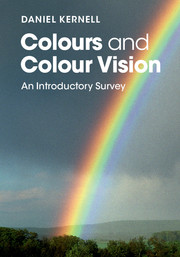Book contents
- Frontmatter
- Dedication
- Contents
- List of plates
- List of figures
- List of tables
- Preface
- 1 Colour vision in everyday life
- 2 The signals of colours: light and wavelengths
- 3 Colours and viewing conditions: not only local wavelengths
- 4 Our biological hardware: eye and brain
- 5 Eyes with unconventional properties: the ‘red-green blinds’
- 6 Other kinds of unconventional colour vision
- 7 Colour vision in different species of animals
- Appendices
- Appendix A Diagnosis and measurement of differences in colour vision
- Appendix B Specification and measurement of colours
- Appendix C Light and lighting
- Appendix D Digital cameras
- Appendix E Technical terms
- Notes
- References
- Index
- Plate section
Appendix E - Technical terms
from Appendices
Published online by Cambridge University Press: 05 March 2016
- Frontmatter
- Dedication
- Contents
- List of plates
- List of figures
- List of tables
- Preface
- 1 Colour vision in everyday life
- 2 The signals of colours: light and wavelengths
- 3 Colours and viewing conditions: not only local wavelengths
- 4 Our biological hardware: eye and brain
- 5 Eyes with unconventional properties: the ‘red-green blinds’
- 6 Other kinds of unconventional colour vision
- 7 Colour vision in different species of animals
- Appendices
- Appendix A Diagnosis and measurement of differences in colour vision
- Appendix B Specification and measurement of colours
- Appendix C Light and lighting
- Appendix D Digital cameras
- Appendix E Technical terms
- Notes
- References
- Index
- Plate section
Summary
achromat - person who is unable to see chromatic colour; might be inherited (rod achromat) or due to brain damage; state: achromatopsia
achromatic colour - colour lacking hue; i.e. white, grey or black
anomalous trichromat - person with three types of cones, one of which has deviant properties; needs three primary colours for admixture of all hues, although typically in non-normal proportions
blind spot - blind area enclosed within portions of the retina and visual field, exit site of the optic nerve (optic disc), hence lacking visual receptor cells
brightness - apparent intensity/amount of light in a visual percept (Plate 1.1)
chromatic colour - colours with a hue, i.e. all colours except white/grey/black; cf. achromatic colour
chromaticity - hue and level of saturation
colourfulness - relative degree of saturation or ‘purity’ of a chromatic colour (Plate 1.1)
complementary colours - pair of hues for which an additive mixture may become white; each spectral and extra-spectral hue has its own complementary colour
cones - class of receptor cells of the retina, used for photopic vision in normal daylight; three types with different wavelength sensitivity (L long, M middle, S short wavelengths); essential for seeing colours and fine detail
dark adaptation - adjustment of the sensitivity of visual receptor cells and the processing in the visual neuronal system to a decreased light intensity (e.g. from day to night)
deuteranomal - person with an inherited disturbance of red-green colour vision in which the M cones have deviant properties, state: deuteranomaly
deuteranope - person with an inherited disturbance of red-green colour vision in which the M cones are non-functional; state: deuteranopia
dichromat - person with two types of functional cones, needs only two primary colours for admixture of all hues; state: dichromacy
dominant wavelength - wavelength of spectral colour that represents the hue for an unsaturated colour; obtained using CIE charts (Figure B.1)
elementary colours - six colours perceived as ‘unique’ according to Hering's opponent colour system; four are chromatic (blue, yellow, green, red) and two achromatic (white, black)
extra-spectral colours - purple hues, do not occur in the spectrum because they cannot be produced using light of a single wavelength; made with e.g. blue + red
fovea - small retinal region for which acuity is maximal, lies at the centre of the normal gaze direction; […]
- Type
- Chapter
- Information
- Colours and Colour VisionAn Introductory Survey, pp. 224 - 228Publisher: Cambridge University PressPrint publication year: 2016



